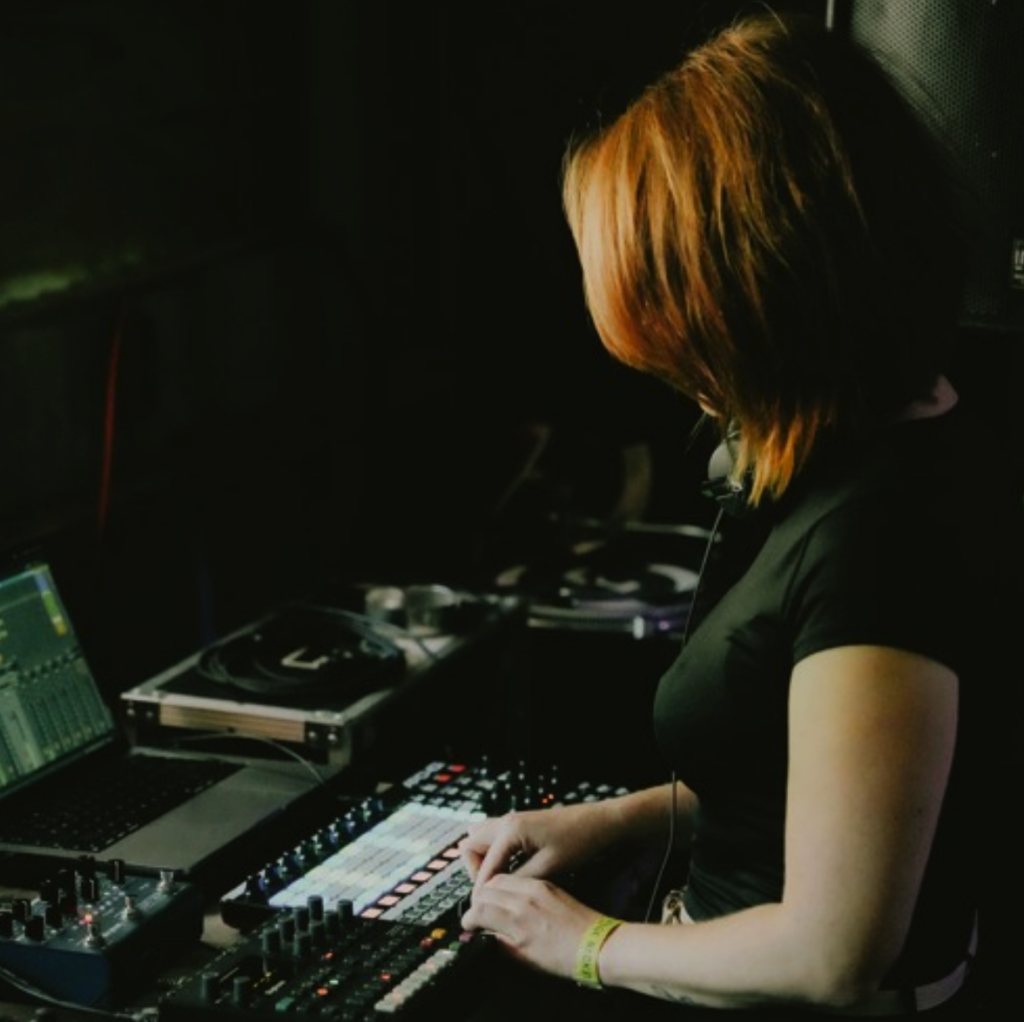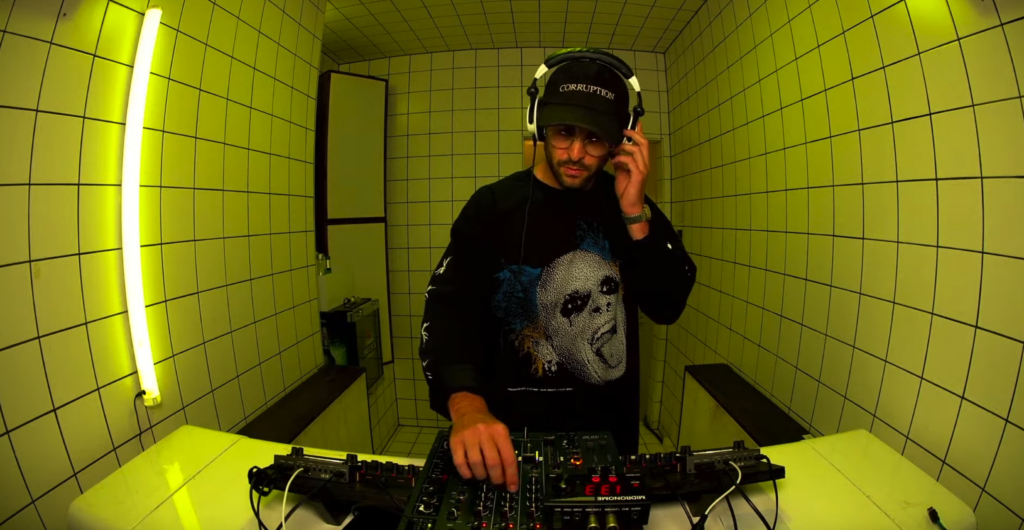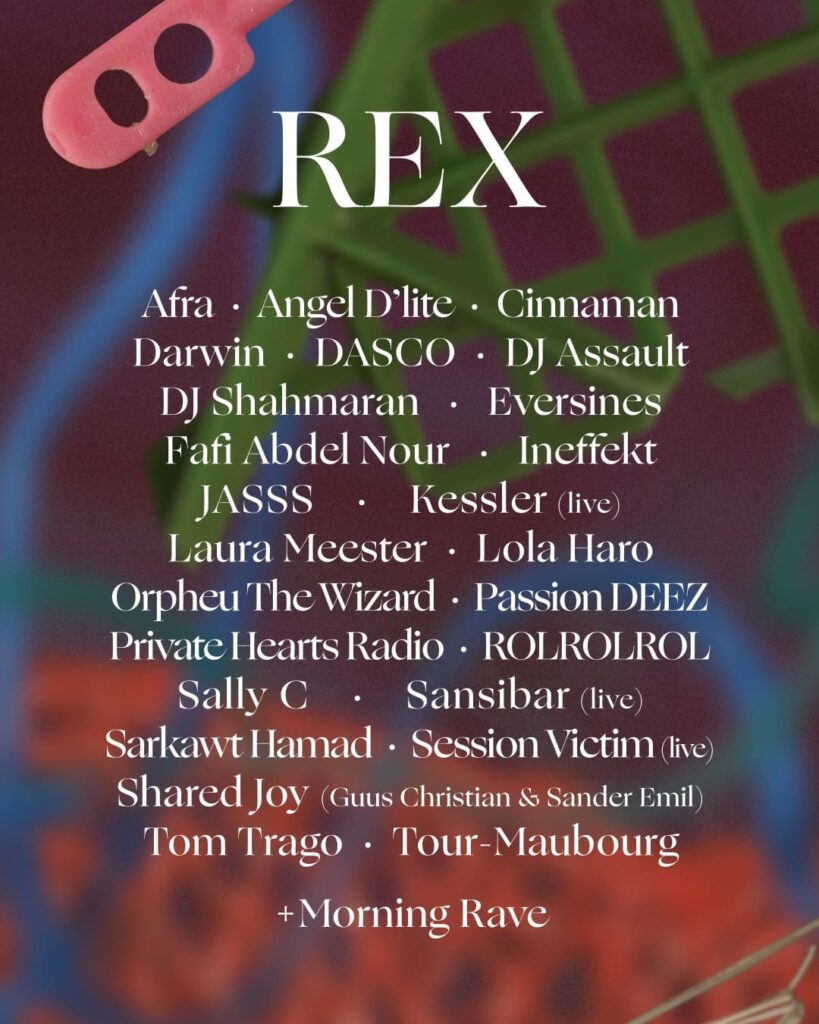Pluie/Noir
Interscapes 02
“Interior Design”
Sound mixed and compiled by Rubi
Visual interpretation by David Surman
Welcome to the new Pluie/Noir podcast series, Interscapes. 8 years after our debut we decided to press the reboot button and return to our roots. With a new format and back to a regular monthly schedule, Pluie/Noir Interscapes will feature audio collages, mixes, live interviews and live recordings from P/N artists, friends, and other collectives we admire.
Because less is more, instead of the usual triptych format, this series will feature one single visual interpretation of the music by a graphic artist. The artwork will be available to purchase in poster format on our rebooted Bandcamp page very soon, with cassettes or CD-r of the mixes as a bonus.
World events have taken the series out of its planned monthly schedule, but priority was on the safety and functional structure of the private lives of everyone involved in the project during these unprecedented times.
For Interscapes 02 we welcome Rubi, a versatile german artist based in Myanmar, with a visual interpretation by english painter David Surman. You can learn more about them right here:

INTERVIEW — RUBI
Hi Christina, welcome to the P/N Interscapes series. How have you been?
Hi there, and thank you so much for having me on your wonderful series! <3 I’m good, I’m enjoying what I can from the comfort of my own home together with my little kitty, currently working online and otherwise painting and reading a lot or watching movies!
Why did you move to Southeast Asia? Was it mere chance or a long-term goal?
A little bit of both, but I’d say it was intentional I moved here initially only for a short-term gig of three months early 2017 which I found really quite randomly but was very intrigued by. And honestly, I just liked it so much that I felt like I needed to come back and spend more time!
I moved back to Yangon, Myanmar in August 2018 and have been here since, and I deeply love it – there’s a different energy in the air in Southeast Asia, people are kind and positive everywhere around you and there is still so much space on an economic and artistic level that it’s a very fulfilling place to be!

“there’s a different energy in the air in Southeast Asia, people are kind and positive everywhere around you and there is still so much space on an economic and artistic level that it’s a very fulfilling place to be!”
Your endeavours seem pretty vast. What did you study, what do you do for a living, and how do you entangle it with music?
Ha, I’m an economist and data scientist during the day. I’ve always been listening to and surrounding myself with music, but actually got deeper into DJing when I started my PhD in Barcelona in 2013 – I just felt like at the end of a long, mentally draining day I needed to use a very different part of my brain to really relax and let go, and getting creative with the music perfectly hit the spot. I’m currently teaching at a Liberal Arts and Sciences Institute here in Myanmar, which has the goal of bringing quality education to students from different walks of life, particularly those from ethnic minorities and less privileged backgrounds.
I finally got to combine my two worlds by teaching a class in music psychology this term, where we are exploring the role of music in everyone’s life from early childhood, how it is used as a social identifier and its connection to politics and conflict. My students are in their early 20s, and I’ve put them on the guestlist for several of the club nights I’ve organized here and they think it’s the coolest thing ever to see their professor behind the decks haha!

How is the audio-visual arts scene in Myanmar and the surrounding Nations? Are you helping activate it somehow and what are you working on nowadays?
I’d say the scene particularly in this part of Asia is at an early stage compared to Europe, but driven by a lot of passion and daring, forward-thinking people. In most of the major cities, you’ll find a beautiful venue and a small dedicated crew of people behind it – some of my favourite places I’ve played at in the area are Savage and Observatory in Vietnam, the Resonant crew at B1 in Taipei and Club Kowloon in Hong Kong. Also, the early-stage vibe brings the liberating attitude that as a DJ it’s really just about making people dance, and there’s no ego yet about the tracks you play or how you achieve this – if you can manage a dance floor, you get a stamp of approval.
Myanmar I’d say is the youngest scene by yet another margin, particularly because of its very recent coming-out of a military dictatorship. There’s a small number of local DJs and very few venues that dare to program (non-EDM) electronic music, and I was lucky to get a residency in my favourite club in town within the first month of arriving! I started my Out Of Sight events here, a monthly series which gained a very regular following and is the only one with international bookings in the whole country. Upon coming here, I didn’t really think I’d get to start another series of my own, especially inviting over so many DJ friends to come to visit and also contribute and explore the country while they’re here. Honestly, part of my joy in doing this has purely been getting inspired myself by seeing people play, bringing together a community of friends to dance through the night and just have a really great time.

“it’s really just about making people dance, and there’s no ego yet about the tracks you play or how you achieve this – if you can manage a dance floor, you get a stamp of approval. “
Tell us more about “Interior Design”: How, why, when?
I’ve recorded this podcast at home in Yangon, on a chill midweek evening when I felt a little spark of inspiration. I honestly take forever to record podcasts, as you already know from me submitting this so late. I get deeply into overthinking mode and since I don’t publish many mixes I want them to have a specific theme and vision behind instead of just putting tracks together – which usually ends up with me procrastinating for months until it finally clicks and I know exactly what I want to do. There are quite a few tempo changes inside as I tried to create an arch from very slow ambient tracks to something I’d play in the middle of a night and then back down again. But somehow all of the tracks I put feel deeply me and representative of the style I like, so I identify with it.
The name was a last-minute hunch, but seemed fitting with the current phase of everyone spending time inside their homes and through this discovering maybe not just their furniture but also the building blocks of their inside world.

And music-making? Is it something you want to explore?
I’ve actually gotten into playing acoustic music here with friends in recent months, and that’s been a really fun journey! I have a bunch of instruments at my home, and hosting small jam sessions has been one of my favourite pastimes. All of them are much more talented and experienced than me but have graciously taken me in so I’m constantly learning a lot.
On the electronic music side, I feel most compelled by making more experimental and ambient things as it feels like there is a larger range of freedom for exploration. I’ve been sampling some of the sounds in my surroundings for a while as the hustle and bustle here sounds so different from what I’m used to in Europe, so we’ll see what comes out of it!

“The name was a last-minute hunch, but seemed fitting with the current phase of everyone spending time inside their homes and through this discovering maybe not just their furniture but also the building blocks of their inside world.”
Short, medium and long term goals?
Honestly, I’m a pretty chill person, so my overall goal in life is just to spend my time in an interesting and creative way, surround myself with people I love and somehow leave a positive trace with what I do. If I manage to keep combining all of these things I’ll consider myself a lucky and successful human!
— X —
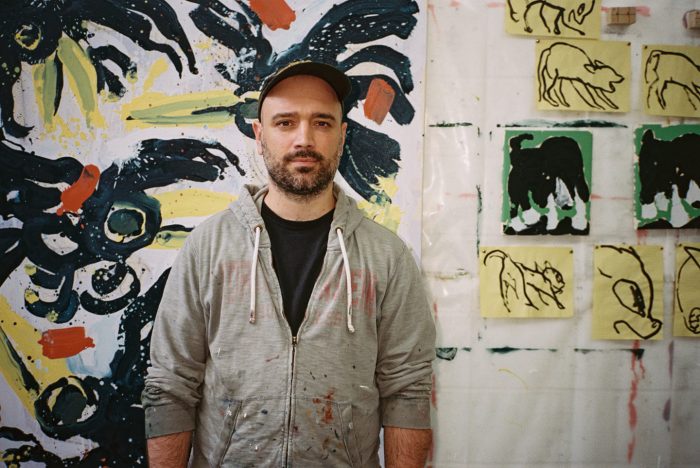
INTERVIEW — DAVID SURMAN
Hi David, such a pleasure to have you at P/N. How are you, all things considered?
Thank you for asking, I’m very good right now. The pandemic has shifted my reality in all sorts of unexpected ways. I had coronavirus after taking a trip to Madrid, then New York. I came back to London and got sick immediately. I’m so glad to have fully recovered. I’m enjoying the empty London.
Have you lived abroad and explored different artistic fields apart from painting, or has it always been about England and canvases?
I was introduced to painting when I was a teenager by an artist Rob Fairley who my dad knew. I had always drawn a lot, but I didn’t consider being a painter until much later. I actually trained to be an animation film director, which seems so ridiculous to me now. I thought of it as a pragmatic choice – the kind of profession which is somewhere between a reliable job and artistic freedom. Little did I know that hand-drawn animation would all but disappear.
I absolutely loved good quality animation, films like Akira and Ghost in the Shell, and the Studio Ghibli films. I wanted to make them, and I also wanted to disappear into them. I started seriously painting again in my early 30s after a decade of working in animation and videogames in the UK and Australia. The timing has been perfect for me, as I started to paint really when I was ready. Australia changed my work, it made me think about colour and light and scale. I made films and animations and games there with my partner Ian Gouldstone before we came back to the UK and I started to paint full time around 2013.
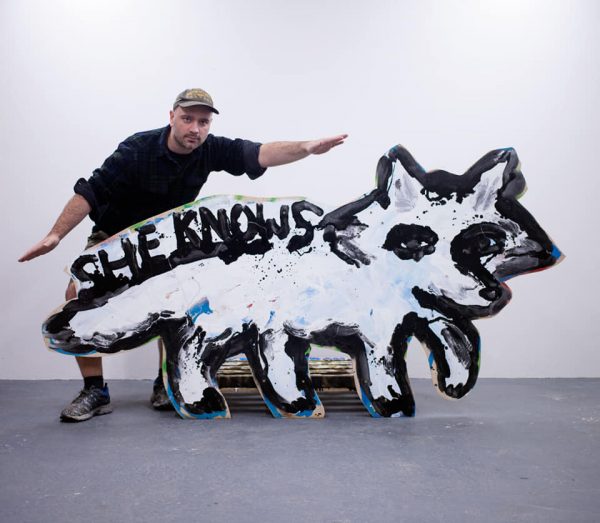
“I absolutely loved good quality animation, films like Akira and Ghost in the Shell, and the Studio Ghibli films. I wanted to make them, and I also wanted to disappear into them.”
I’d discovered your work through Sound Of Vast’s “5th Anniversary Series”. It featured a series of paintings from your “Paintings for the Cat Dimension” exhibition/installation. What was it about?
That was such a wonderful collaboration, and the team at Sound of Vast are brilliant. My exhibition was a series of 12 paintings of the same cat motif, a mother with two kittens, interpreted in 12 different ways. I wanted to make a statement on what it means to paint in the post-internet era, without giving in to the impulse to simply paint or reproduce imagery directly from online culture. So I created a cat motif in response to the prevalence of cats online from the beginning. The real statement though was the stylistic shifting around. I wanted to say “we are playing with identity all the time, why should an artist be an authentic singular identity?” I wanted to show that an artist can wear many masks, and they’re all authentic in representing artistic action.
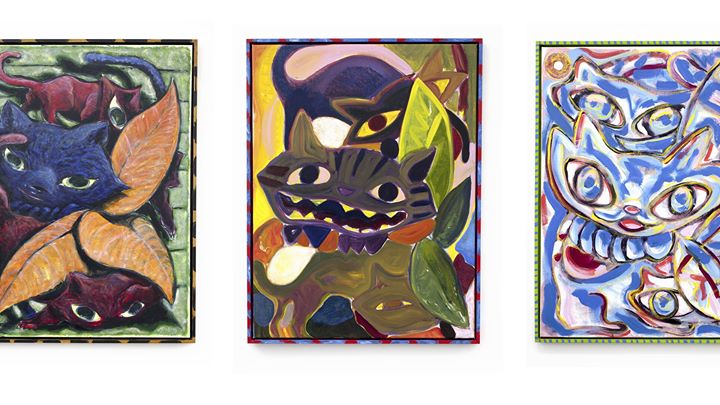
Do you consider the internet, social media and contemporary sub-cultures the biggest influences of your work?
I don’t believe you get to choose your influences so much in art. By the time you’re 8 years old or so, your plastic little brain has been shaped by certain formative things. For me, there are two fascinations, first the natural world, which nourishes the animal side of me. The second is the artificial human world of images, electronic media, videogames, movies, art.
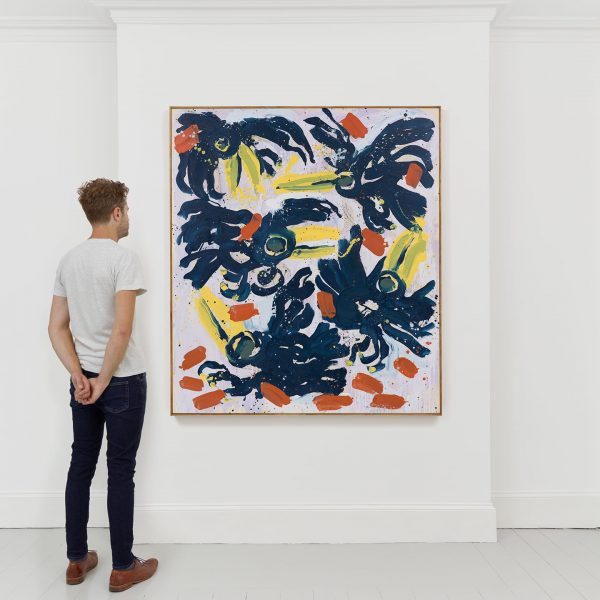
“we are playing with identity all the time, why should an artist be an authentic singular identity?”
As much as I would like to be integrated into nature like a romantic dreamer I firmly believe humans are stuck outside of nature, so we have to make a new nature for ourselves to comfort and distract ourselves. This is art, and it takes many shapes, from youtube to painting to music. I see all these things as fundamentally the same, art is doing something with love. I see a lot of love in internet cultural activity and so it influences me. Though I have no idea how visible all this is in the work.
My approach is also calculated, I am interested in having an impact followed by a slowly shifting understanding, and you need to push colour to achieve that. Also as I have gotten older and become more and more conscious of art history I feel a sort of obligation to have courage with colour and put out my ideas in a clear way.
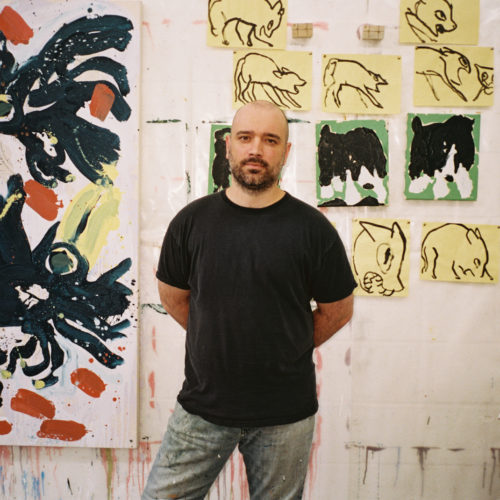
Do you listen to music while painting? Does music have an impact on you while you paint?
I absolutely listen to music when I paint, and I am totally repetitive in my choices. I listen to David Bowie’s discography on repeat, and Kate Bush too. If I need to go to a particular mindset I will listen to Bach, Tchaikovsky, Wagner, Glass. Bowie and Bush are just always there, timeless, every aspect of it is totally known and listening to them while painting just greases everything along nicely. I would like to be a curious listener and search for different music, but I think I’ve become extremely focused on the experiences of the eye, and perhaps not so much the other senses.
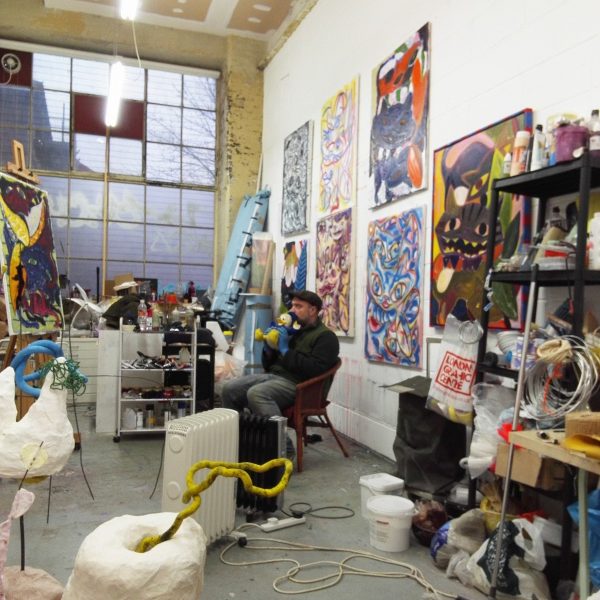
“I firmly believe humans are stuck outside of nature, so we have to make a new nature for ourselves to comfort and distract ourselves.”
Raucous Bird” is your visual interpretation of Rubi’s podcast. Why did you choose this particular work?
Listening to Rubi’s work I was thinking a lot about the space of music, and the way we lose a sense of direction. It becomes spatial, but there isn’t necessarily a top or bottom. This is very different from visual art, which relies a lot on a structure of top, bottom, and so on. It made me think of the paintings of cockatoos I’ve made, who I saw often in Australia, playing fun games in the trees. They appear weightless and live to enjoy the space and their own free bodily movement. For me, the music creates a wonderful association with this memory.
Short, medium and long term goals?
To make exciting paintings that have an impact, and to bring the work to new places. That’s the priority for me at any given time. Thanks so much for asking such great questions.
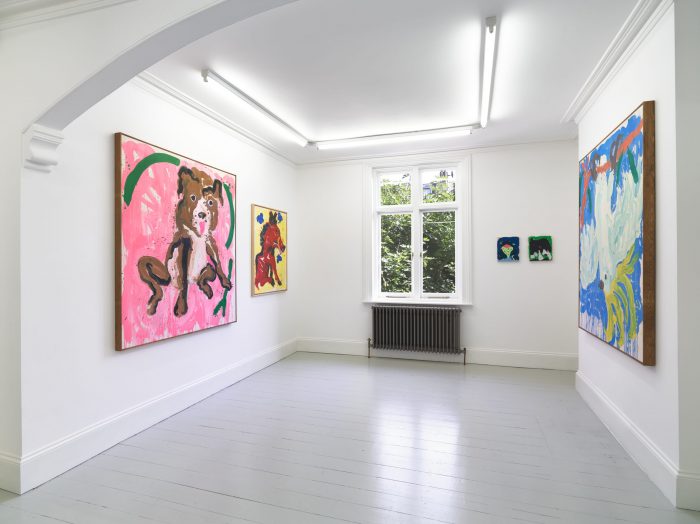
Links:
https://soundcloud.com/itsmerubi
https://www.davidsurman.com
W: https://pluienoir.tumblr.com
M: info (at) pluienoir.com
